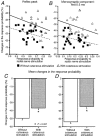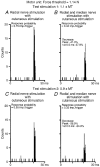Mechanical cutaneous stimulation alters Ia presynaptic inhibition in human wrist extensor muscles: a single motor unit study
- PMID: 10618158
- PMCID: PMC2269737
- DOI: 10.1111/j.1469-7793.2000.0137m.x
Mechanical cutaneous stimulation alters Ia presynaptic inhibition in human wrist extensor muscles: a single motor unit study
Abstract
Reflex responses were evoked by radial nerve stimulation in 25 single motor units in the extensor carpi radialis muscles of seven subjects during voluntary isometric wrist extension. The responses consisted of narrow peaks in the post-stimulus time histograms with latencies compatible with monosynaptic activation. When the skin of the palm and finger tips was continuously swept using a soft rotating brush, the purely monosynaptic components of the motor unit responses, as assessed from the contents of the first two 0.25 ms bins of the peak, were found to increase. This increase did not affect the motoneurone net excitatory drive, as assessed by measuring the mean duration of the inter-spike intervals. The cutaneous inputs activated by the brush may have reduced the tonic presynaptic inhibition exerted on the Ia afferents homonymous to the extensor motor units tested. To further investigate whether Ia presynaptic inhibition was involved, the responses of the extensor motor units were conditioned by stimulating the median nerve 20 ms earlier, using a protocol which is known to induce Ia extensor presynaptic inhibition originating from flexor Ia afferents. The median nerve stimulation did not affect the motoneurone excitatory drive, but led to a decrease in the responses of the extensor motor units to the radial nerve stimulation, especially in the purely monosynaptic components. This decrease was consistent with the Ia presynaptic inhibition known to occur under these stimulation conditions. The cutaneous inputs activated by the brush were found to reduce the Ia presynaptic inhibition generated by the median nerve stimulation, without affecting the distribution of the Ia presynaptic inhibition among the various types of motor units tested. The present data suggest that cutaneous inputs from the palm and finger tips may relieve the Ia presynaptic inhibition exerted on the wrist extensor motor nuclei, and thus enhance the proprioceptive assistance to fit the specific requirements of the ongoing motor task.
Figures



 ) or not (□). Applying cutaneous stimulation was found to reduce the presumed presynaptic inhibition estimated both from the whole peak (C) and from the monosynaptic components (D).
) or not (□). Applying cutaneous stimulation was found to reduce the presumed presynaptic inhibition estimated both from the whole peak (C) and from the monosynaptic components (D).

References
-
- Aimonetti JM, Schmied A, Vedel JP, Pagni S. Presynaptic inhibition in human wrist extensor muscles: dependence on motor task and on cutaneous afferents. Society for Neuroscience Abstracts. 1997;23:200.
-
- Burke D, Gandevia SC, Mckeon B. Monosynaptic and oligosynaptic contributions to human ankle jerk and H reflex. Journal of Neurophysiology. 1984;52:435–448. - PubMed
Publication types
MeSH terms
LinkOut - more resources
Full Text Sources

